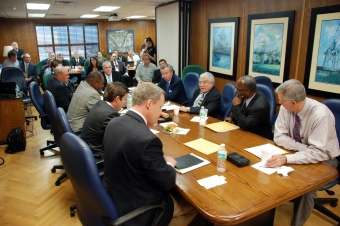Summary:
It is an activity that focuses on comparison of terms of production sharing agreements in different countries that stipulate the supply obligation of the internal market. This will promote a practical approach on the themes of (in)completeness of contract writing and allocation of risks, causing students to differentiate the former allocation mechanisms ante and ex post allocation mechanisms. In order to that, students are put in contact with the models of production sharing contracts in Brazil, India and Angola and also with the relevant regulations in each country, and urged to speak out about the different ways of conceiving the obligation of the domestic market supply. This dynamics was applied both before and after the "Petrobras Case: Contract Analysis (3) - Qualification and Regulation of Oil Exploration and Production Contracts" dynamics.
Objective:
- GENERAL GOAL: It is to know and understand the risk allocation options in sharing contract models and its connection with economic peculiarities of each country.
- SPECIFIC GOAL: It is to present the sharing agreement and discuss the degree of detail of the national market supply clauses of Brazil, India and Angola contracts, also the allocation of the theme of - ex ante and ex post - of risks from contract.
- Take students to produce a comparative table, covering the arrangements for providing each contract production sharing/regulation. - Thus, it is intended that students are able to distinguish between ex ante and ex post risk allocation mechanisms used in the contracts and relate them to the economic peculiarities of each country.
Dynamics:
- TEACHING METHOD: Critical reading, in which students should critically read a brief history of the position occupied by the countries in terms of production and exploration of oil and also the contracts for production sharing in each country;
- REQUIREMENTS: There is no previous required reading. Reading materials are available during the workshop; - INTRODUCTION TO THE DYNAMICS: at the beginning of class (10min), the professor delivers and comments to the students a short text explaining that they should promote a comparison between the production sharing contracts - and the legal rules applicable to them - Brazil, India and Angola, and providing information about India and Angola to justify the choice of countries (importer/exporter, exploration risk, etc.);
- DEVELOPMENT OF THE DYNAMICS: the students gather in groups of four members and are placed in contact with the contracts and laws of these countries. It demands that the groups produce a comparative table (1 hour of activity), which incorporates the provisions of each one of the production of sharing/regulation contracts - and reflection on any differences - on the following aspects: (i) the existence of predictions of the domestic market supply (and if so, how it was designed - always considering both the contract and the regulation); (ii) the circumstances change predictions (and if so, how it was designed - always considering both the contract and the regulation); (iii) the prediction of an unforeseeable circumstance and greater force (and if so, how it was designed - always considering both the contract and the regulation); and (iv) the possibility of changing the percentage on the profit on oil sharing; (v) ensuring the right of cost oil ownership; and (vi) the change in the term of the contract. The extent of the exercise requires that all group members wield effectively contracts and the regulation of each country. The professor walked around them to say the question of risk allocation mechanisms through ex ante and ex post, prompting students to fit aspects that seek the division, as well as answer any doubts and share them to the class. The final product, that was to be sent to the professor after class, was the comparative table;
- END OF THE DYNAMICS: The professor makes comments at the beginning of the next class (30 min) on the forwarded frames and the general framework, promoting a Socratical dialogue for students to express their perceptions in terms of different designs of national market supply clauses;
- ATTENTION IN THE ACTIVITY:
1) During the development of the activities, it was noted that the identification and consideration of all aspects committed the working time of groups. To avoid this, it can be distributed some aspects or models for different groups, allowing a discussion led by the professor in the end of the class for universal findings and reflections.
2) It is recommended that the professor thinks about the need of a previous preparation for the most detailed activity with a more synthetic end, or a more detailed end with a more synthetic previous preparation.
OBSERVATION:
1) To make it clear to students that are treating of ex ante and ex post mechanisms of risk allocation, the professor can determine a mandatory prior reading and/or make timely interventions during the discussions of the groups. The professor can also make interventions and make the reading available later.
Evaluation:
- FEEDBACK: Part of the feedback is made to students during group work. The professor circulates among the groups and comments on the preparation of the comparative table. During the collective discussion, the professor comments about the comparative tables in general. Subsequently, the comparative tables will be returned with the specific comments.
- GRADE EVALUATION: the comparative table will be worth of 4 points (and will be aggregated with the exercise of plenary, worth of 6 points). This grade makes up part of the general activity evaluated to the course participation grade. The correction criteria will be: (i) the identification of aspects in three models - Brazilian, Indian, and Angolan - including the contract and regulation (2 points); and (ii) the analysis of aspects regarding (a) the strategy connection of ex ante and ex post, (b) the identification of ambiguous, vague and appropriate clauses and (c) to the contractual strategy connection with the underlying economic environment (2 points).
Observation:
Copyright from the cover page image (cropped):
Image: "Pozos de Ambición", 2007, available by the Flicker user "Javi", under the Creative Commons BY-SA 2.0 license






